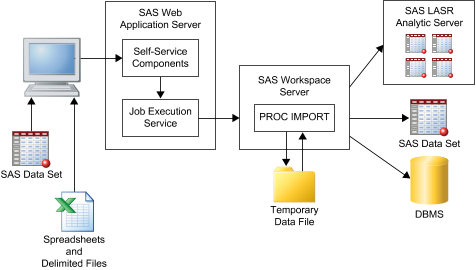Import a Local Data File
When you import a local data file from your desktop, such as a spreadsheet, a delimited text file, or a SAS data set, the file is transferred as data to SAS LASR Analytic Server. This enables you to
access data without needing assistance from an administrator or information technology
group.
The following figure
shows how a file is accessed from your PC, transferred to the SAS
Workspace Server, and then stored in an output table.

Note: When you import a SAS data
set, it is not processed with PROC IMPORT. SAS data sets are transferred
to output with a DATA step.
Note: Only
the data builder can output a SAS data set or a DBMS table. The explorer
and designer can import data to SAS LASR Analytic Server only.
You can import data
files that are available from the file systems on your PC. This includes
local file systems such as
C:\ on Windows
machines and paths such as /home/$USER on
UNIX machines. Network file systems and shared folders are included,
such as UNC paths like \\nas\spreadsheets.
To import data from
a Microsoft Excel spreadsheet, delimited text file, ZIP file, or SAS
data set:
-
In the Import Data window, click the link for the type of data file that you want to import, and then select the file.
-
Specify the following input file options:Note: For a SAS data set, there are no options to specify.Spreadsheet optionsThe following options are available when you import a Microsoft Excel spreadsheet:Select All or select the check boxes for the worksheets to import.The default is to import data from the first row of the spreadsheet. If the data begins on a different row, select the row.Select this check box when the row on which to begin the import has the column names.Text file optionsThe following options are available when you import a delimited text file or a ZIP file:DelimiterSelect the delimiter that is used in the file that you want to import. You can specify a single character to use as a user-defined delimiter.Select this check box when the file has the column names on the first row.The default is to import data records from the second row. If you deselect First row contains column names, then this value indicates the first row.The default is to read up to the first 500 rows in the file to determine the data type and length for each column. A smaller value causes the import to complete quickly, but you risk the chance of determining a value too short for character columns. Larger values reduce the chance of truncating character columns, but they increase processing time.EncodingSelect the encoding of the file. If you are importing UTF-8 or UTF-16 data, then make sure that the SAS Web Application Server is a Unicode server or that all of the file contents can be successfully transcoded to the encoding of the SAS Web Application Server.
-
(Optional) Click Preview to view the data. Preview displays up to 500 rows from the file.TipPreviewing the data can help you determine whether you specified the correct encoding.
-
(Optional) In the Output Table section, enter the name for the output table and a description. The description is limited to 256 characters. Review the library and location settings by clicking Advanced. Make any necessary changes.You do not have access to the Advanced section if you are using the explorer or designer and do not have the Build Data capability. Instead, you can import the data to a general-purpose area or select Store the table in a private location to prevent other users from accessing the data.
-
Click OK.
Copyright © SAS Institute Inc. All Rights Reserved.
Last updated: January 8, 2019